Scott Eastwood Pacific Rim: Uprising
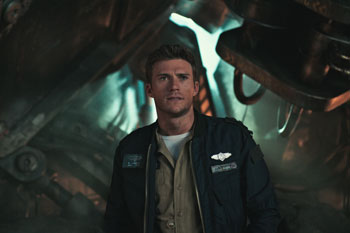
Back to the Breach
Cast: Scott Eastwood, Charlie Day, John Boyega, Rinko Kikuchi, Tian Jing, Adria Arjona, Burn Gorman, Levi Meaden
Director: Steven S. DeKnight
Genre: Action, Animation
Rated: M
Running Time: 111 minutes
Synopsis: The globe-spanning conflict between otherworldly monsters of mass destruction and the human-piloted super-machines built to vanquish them was only a prelude to the all-out assault on humanity in Pacific Rim Uprising.
John Boyega (Star Wars series, Detroit) stars as the rebellious Jake Pentecost, a once-promising Jaeger pilot whose legendary father gave his life to secure humanity's victory against the monstrous "Kaiju." Jake has since abandoned his training only to become caught up in a criminal underworld. But when an even more unstoppable threat is unleashed to tear through our cities and bring the world to its knees, he is given one last chance to live up to his father's legacy by his estranged sister, Mako Mori (Rinko Kikuchi, Babel)"who is leading a brave new generation of pilots that have grown up in the shadow of war. As they seek justice for the fallen, their only hope is to unite together in a global uprising against the forces of extinction.
Jake is joined by gifted rival pilot Lambert (The Fate of the Furious' Scott Eastwood), as well as the courageous and conflicted Jules Reyes (Adria Arjona of Emerald City) and 15-year-old Jaeger hacker Amara (newcomer Cailee Spaeny), as the heroes of the Pan Pacific Defense Corps (PPDC) become the only family he has left. Rising up to become the most powerful defense force to ever walk the earth, they will set course for a spectacular all-new adventure on a towering scale.
Also reprising their roles from Pacific Rim are Burn Gorman and Charlie Day as Dr. Hermann Gottlieb and Dr. Newt Geiszler, two of the most brilliant scientists the world has ever seen…now both on the frontlines of Kaiju defense as part of the original team that closed the Breach. Additional newcomers to the series include Jing Tian (The Great Wall) as Shao Liwen, CEO of Shao industries and a believer in an unmanned drone Jaeger corps, and Chinese superstar Max Zhang as Marshal Quan, the team's laser-focused supervisor.
Pacific Rim: Uprising
Release Date: March 22nd, 2018
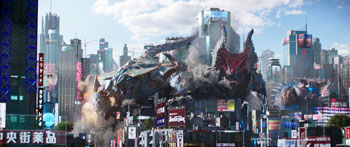 About The Production
About The Production
Back to the Breach: Pacific Rim Uprising Begins
In Pacific Rim, a Breach opened at the bottom of the Pacific Ocean, and through it emerged giant Kaiju, monsters engineered by the alien Precursors to move from dimension to dimension terraforming planets"exterminating the indigenous species and taking full territorial control.
These Kaiju unleashed their fury on coastal cities along the Pacific Rim, and proved virtually unstoppable with conventional weapons. Giant robotic warriors called Jaegers"piloted by humans connected by a neural bridge"were engineered to fight back. Jaeger Gipsy Danger successfully closed the Breach by detonating a nuclear bomb, helped by legendary Jaeger Marshal Stacker Pentecost, who gave his life to ensure the success of the operation.
Pacific Rim Uprising continues the mythology of a richly detailed, wholly original sci-fi universe. With a focus on complex, richly diverse characters, the film is a global adventure"taking the audience from the slums of a future Los Angeles, to China, Tokyo, Australia and deep into the icy reaches of Siberia. With multi-generational and multi-cultural appeal, this is an emotionally charged, visually spectacular film about the battle for our planet and inspiring human heroism on a whole new scale.
It is the year 2035, 10 years after the events of the first film, in which humanity supposedly defeated the threat of the Kaiju. The war is over. The Breach, the gateway beneath the Pacific Ocean that spawned the Kaiju, has been closed, but the fear that these unrelenting beasts from another dimension may somehow rise again is ever-present.
Vigilance has become a way of life, and the PPDC has been reborn as a global force of highly advanced robotic warriors, with a new generation of young pilots at the helm. When an even more deadly Kaiju threat emerges, these young fighters"dubbed the Cadets"are powered by a drive to avenge and to protect what is left of the world they inherited.
Earth has had a chance to repair, but is in a state of heightened tension. In Los Angeles, Jake Pentecost, son of Stacker Pentecost and a former star Academy pilot, is now a black market scavenger for Jaeger parts. While trying to steal a highly valuable tertiary plasma capacitator, he encounters young Amara, an orphan of the Kaiju War who found out the hard way that the PPDC Jaegers weren't just going to show up and save her, so she built her own: Scrapper. With a highly gifted engineering mind, she built her mech guardian angel with parts scavenged from the Santa Monica aftermath. Newly arrested, Jake is given the option"by his estranged adoptive sister and high-ranking PPDC official Mako Mori"of having a long list of charges dropped. One condition: he must agree to help train the young cadet Cadets at the Moyulan Shatterdome in China, alongside his former friend and now rival, Nate Lambert. Two men who were once closer than brothers, their relationship was damaged when Jake walked away from their shared destiny of being great Jaeger pilots.
The PPDC is not only training these Cadets, but building an advanced new breed of Jaegers in case the Kaiju ever return. A rival drone Jaeger program, developed by Liwen Shao and her company Shao Industries is also now in play. It would take the pilots out of the Jaegers and control the machines remotely, causing conflict and resentment for the pilots and cadets.
While the Cadets are training to fight off the Kaiju, a new enemy appears at the 10-year end of war celebrations in Sydney in the form of a sleek and devastating rogue Jaeger, Obsidian Fury"a terrifyingly powerful opponent that Gipsy Danger will be lucky to survive. The new drones turn on their makers, igniting an unexpected Jaeger-versus-Jaeger conflict and sending the PPDC and the Cadets on a quest to find out who or what is giving this new threat a deadly edge that makes it nearly impossible to defeat.
As the Jaegers go to war, a hidden threat like nothing humanity has seen triggers multiple Breaches to open up across the Pacific Rim, and the Kaiju return, more massive and more dangerous than ever. Jake and Lambert must determine how the new otherworldly threat is tied to the rogue mechs before it is too late…as Amara and her fellow recruits must defy youth and inexperience in the battlefield to defend our world.
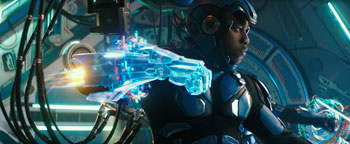 In approaching the second chapter in the series, Legendary wanted to ensure that they were crafting an innovative vision, one that, while honoring the first film, would present a bold new interpretation of the Pacific Rim universe. Producer Cale Boyter reflects: "Legendary has always had a signature attitude in everything that we do, and this was the opportunity to create a perfect representation of what the brand represents, and how it wants it to evolve."
In approaching the second chapter in the series, Legendary wanted to ensure that they were crafting an innovative vision, one that, while honoring the first film, would present a bold new interpretation of the Pacific Rim universe. Producer Cale Boyter reflects: "Legendary has always had a signature attitude in everything that we do, and this was the opportunity to create a perfect representation of what the brand represents, and how it wants it to evolve." It was important to the production team that no film exist without the perfect story. "There's a lot of cynicism towards sequels," Cale Boyter admits, "and we were conscious of that. We had to ask ourselves 'How do we create something that is going to take people by surprise?'"
An important step for producers Mary Parent and Clae Boyter was bringing in Steven S. DeKnight, known for creating and running the hit Starz television series Spartacus, as well as running the first season of the Marvel/Netflix series Daredevil. Steven S. DeKnight understood Legendary's commitment to innovative storytelling, and pitched a compelling tale that checked a lot of boxes for the producers.
Within this universe of monsters and mechs was a core human message and compelling emotional story arcs. "Steven S. DeKnight is a genre blender," commends Boyter. "In his concept, the story didn't function like a simple sequel to Pacific Rim. The big idea that he started with was that anybody can make a difference. Taking that core message, the story focuses around Stacker Pentecost's troubled son Jake, and the young, orphaned mechanical genius Amara alongside him"two broken people who overcome their situations and their mistakes, and end up making an enormous difference."
The story would also introduce a new generation of pilots"the cadets nicknamed the Cadets, teenagers who have been intensively training to be Jaeger pilots since they were small kids. It would also create intrigue around the return of the Kaiju, and if this return may have been facilitated by rogue human intervention. Boyter says: "The script we developed has the incredible, big action elements and the human arc around Jake and Amara, but is also a mystery adventure story. It's 10 or 15 minutes into the picture before you realise you're in the Pacific Rim world. The tone and the pace would not just be more emotional, but more kinetic."
Legendary"buoyed by returning fellow producers del Toro, Thomas Tull and Jon Jashni"would team up with Universal Pictures, engaging with the studio early in the creative process. Boyter explains: "We walked Universal through what we were doing. We created a pre-visualisation presentation and showed them concepts and key moments from the movie, and they loved it. It made them enthusiastic about what we were embarking on together."
Enter Jake Pentecost: Boyega Joins the Production
With production greenlit, one of the next vital questions to answer was who would play the lead role of Jake, wayward son of the legendary war hero Stacker Pentecost? For Steven S. DeKnight and the film's producers, one actor immediately rose to the top of the list: John Boyega.
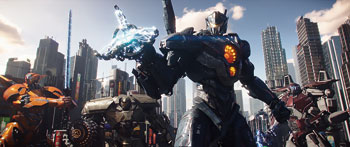 John Boyega, the breakout star of Star Wars: The Force Awakens, wasn't simply interested in acting in his next project. He felt that if he would give the time and energy necessary to be on set, then he would want to serve as an on-set producer. He recalls: "I had set up my own production company and went to Hollywood to introduce myself. One of the scheduled meetings was at Legendary, with Mary Parent and Cale Boyter. We talked about various projects, but at one point Mary said 'We're looking to do a sequel to Pacific Rim. Would you be interested in taking a look at a few things?'
John Boyega, the breakout star of Star Wars: The Force Awakens, wasn't simply interested in acting in his next project. He felt that if he would give the time and energy necessary to be on set, then he would want to serve as an on-set producer. He recalls: "I had set up my own production company and went to Hollywood to introduce myself. One of the scheduled meetings was at Legendary, with Mary Parent and Cale Boyter. We talked about various projects, but at one point Mary said 'We're looking to do a sequel to Pacific Rim. Would you be interested in taking a look at a few things?' "I said 'yes, of course' and we went into the room next door where they had this incredible concept art on display, depicting me in this incredibly designed suit," he continues. "It was a fully developed pitch with Cale Boyter showing me all the amazing new elements for the film, featuring me." He laughs, "They cornered me, I have to say!"
Pacific Rim had made a big impression on Cale Boyega, in the days before he broke out as a star. "Seeing Idris Elba in the first film was very important to me. At the time I was involved in acting on a small scale in drama clubs, and in 2013 I saw a print ad while I was on the bus"Idris Elba as Stacker in an all-black Jaeger suit. The image, and what it represented, immediately struck me and motivated me."
Steven S. DeKnight offers that he couldn't have been more excited at the choice: "I was thrilled when I found out that John was interested. I met with him, and we were both very excited about the possibilities of what we could do with the franchise. He's a classic hero, but can play the hero and the anti-hero at the same time. Jake Pentecost starts out as a thief and ends up saving the world. John has all the qualities you would want for that type of role; he's charming, smart and funny. He brings a real Harrison Ford as Indiana Jones quality to the character."
Boyter adds: "John immediately got it, and it's a great feeling when you have an actor like him who understands what the mission is, and then helps evolve that game plan almost every day."
The film opens with Jake, under the cover of night, involved in a nefarious activity: stealing Jaeger parts from a PPDC scrapyard. He's caught and presented with two options: face incarceration, or use his natural talents at the Moyulan Shutterdome, training young cadets.
On his character, Boyega expands: "Jake's personality is nuanced and conflicted. He grew up in the shadow of his father, Stacker, and he's battled with living up to the family name. He had aspirations to be a Jaeger pilot, and began training at the PPDC Academy, but they were halted after a confrontation with Stacker led him to rebel and follow a dangerous path. What follows that is his journey to becoming a hero."
Boyega wanted Jake to possess an element of Stacker in terms of presence, energy and authority, but to be someone very different; for audiences to recognise the rebel in him that Stacker didn't agree with. "That's something that I decided to create based on how I saw myself when I was 16 and 17"a cocky kid with a little bit of mismanagement."
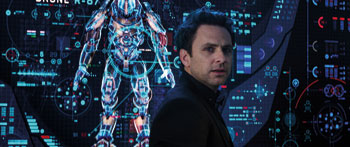 The multi-talent welcomed his dual rule over the course of the massive production. "In my previous films, I was just an actor," Boyega says. "Now I'd be a producer as well, and I loved the challenge of having to live up to that form of leadership, co-producing alongside a studio that I admire, acting in a fantastic role, and working with Steven S. DeKnight"someone I've wanted to work with after his incredible work on Spartacus and Daredevil."
The multi-talent welcomed his dual rule over the course of the massive production. "In my previous films, I was just an actor," Boyega says. "Now I'd be a producer as well, and I loved the challenge of having to live up to that form of leadership, co-producing alongside a studio that I admire, acting in a fantastic role, and working with Steven S. DeKnight"someone I've wanted to work with after his incredible work on Spartacus and Daredevil." "One of the reasons why he is so great is because he's collaborative, and his notes are accurate to character," continues Boyega. "I've been blessed in my career to meet directors who have a great balance between technical knowledge and artistic knowledge, and Steven S. DeKnight has a way of directing to make it all feel seamless. It felt like we worked as one. He's fantastic."
The dual role of star and producer presented complex challenges for Boyega, which in the end could enhance the entire production. "Being a producer was interesting because any decision I helped make outside the character affected the role. When it came to casting the other actors, when it came to set pieces, action sequences, dialogue, it was all a jigsaw puzzle in which I had to make decisions and give opinions to support the character I felt needed to be created."
Boyter points to the actor's particular skill in creating the necessary empathy required by the role. "The tone and the humanity John brought were vital. He's such an accomplished actor"he can make you care, he has a charm such that his character can do morally questionable things but you still love him, which is so important of course in telling a redemption tale."
That inspirational reaction the young Boyega had, on seeing Elba in the Pacific Rim poster a few years earlier, would be key to the overall impact the film sets out to have on its audience. "Ultimately, the film is about people coming together to fight for a common good," shares Steven S. DeKnight. "It doesn't matter where you came from"everybody has a chance to make a difference. Everybody has a chance to be a hero. That was a message that strongly spoke to all of us working on this movie, and we wanted to convey that to the younger audience."
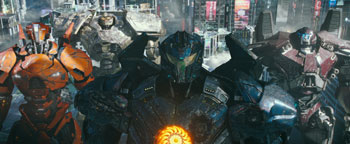 Pilots and Warriors: Key Cast of the Epic Adventure
Pilots and Warriors: Key Cast of the Epic Adventure Pacific Rim Uprising features a diverse blend of favorite characters and exciting new faces, to reward both fans and new audiences alike. The focus in character and casting was on diversity. Humanity unites in the film, ignoring religion, race or background, and director DeKnight and the producers wanted to reflect that ethos in the cast of the film.
"The global aspect of this story is what drew me to doing it," says DeKnight. "The Pacific Rim touches so many different countries, and we wanted to reflect that. We didn't want it to feel forced; it's very organic that the world comes together to fight this global threat, that encourages everyone to put aside their differences, which is a fantastic message for this day and age."
In first film, Stacker Pentecost brought in Mako Mori to become part of their family, which ultimately caused tension for the young Jake. Boyega explains: "After Stacker took in Mako, the trajectory changed. Jake and Stacker couldn't see eye to eye, and Mako was caught between the two. It was hard for Jake to live in the household knowing that Mako lived up to Stacker's image of an ideal child, and that tension led to Jake leaving."
It's Mako's belief in her adoptive brother's capabilities, and events surrounding her, which propel Jake down the hero's path.
Young Amara, whom he encounters in the film's opening sequence and with whom he is dispatched to the Shatterdome, is also vitally important in Jake's growth. Boyter says: "There's a lot of stuff that Jake has to overcome, but playing the father figure to Amara helps him to open up and let go of the frustration and the pain that he felt toward his own father."
Nathan Lambert is a PPDC Ranger, one of the best pilots in the fleet, and heads up the training program for the Cadets, instructing and grooming the young, precocious cadets. Lambert and Jake grew up and trained together, and were best of friends until Jake ran away from the PPDC without a word to his compatriot. In Pacific Rim Uprising, the two have no choice but to heal, or ignore, their past"their combined talents are vital to combatting the rogue mechs and Kaiju.
Of the relationship, Boyega shares: "Lambert was hurt by Jake deciding to leave and not explain himself. When they face each other again, Lambert says 'You can't just go in and out of my life and not value me as a friend, as your brother.' They're trying to work out how to get back to where they were."
His methods are rigid and smack of hard love, but for good reason. Eastwood, who portrays Lambert, states: "He's very sure of himself, very set in his beliefs. He's not hard on them for no reason; he's trying to train these young kids to one day defend lives. There's not a lot of room for pleasantries when it comes to life and death."
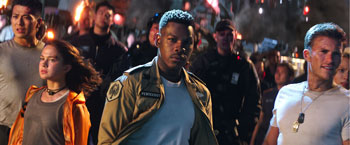 Eastwood was drawn to the characters and their story arcs, not just by the impressive action sequences. "You can have all the big visual effects, but if you don't have characters that you can fall in love with, then you're disconnected during the big action scenes," he sums. "If you're able to go on a journey with them, it makes it a far more powerful film for the audience."
Eastwood was drawn to the characters and their story arcs, not just by the impressive action sequences. "You can have all the big visual effects, but if you don't have characters that you can fall in love with, then you're disconnected during the big action scenes," he sums. "If you're able to go on a journey with them, it makes it a far more powerful film for the audience." The actor also appreciated the vulnerability during the battle scenes. "What I love about the film is that you're wearing these suits and operating these Jaegers, but you're still just a human being. You don't have special powers; you can get hurt or die. You're just a human trying to fight in this war. I thought that was interesting. It wasn't mystical; it was based in reality."
Orphaned during the Kaiju attacks a decade prior, Amara lives alone in an abandoned building in Santa Monica. Street smart and with a fiery personality, she's driven by the fierce need to be prepared when the Kaiju return. In a situation that would defeat many, she nurtured her extraordinary innate engineering talent, building her own Jaeger, Scrapper, from spare parts.
Newcomer Cailee Spaeny, who portrays Amara, had previously acted in short films but lives far from major filmmaking centers. The Springfield, Missouri, native's audition for Pacific Rim Uprising was self-taped, but rather than simply standing in front of a white wall reading lines…she went all out to create an effective audition.
"Because I don't have a lot to do in my small town, I took a whole day to prepare," the young performer reflects. "The air conditioning wasn't working, so I was really sweating, I had a hood on, dirt on my face and I was rolling around on the floor with a pipe in my hand, with television remotes as Scrapper buttons and a stepstool to get into the Conn-Pod. When I sent the tape off, I thought they might think I'm crazy…or they might love it!"
DeKnight and the producers were intrigued by the young actress' talent and inventiveness, and a week later flew Spaeny out to Los Angeles. "I met Steven, then had a day to take in his notes and prepare before I read with John. It was something I'd never experienced before, leaving an audition, feeling like I'd been working with a team. In a lot of auditions, you feel like the pressure is on you, but I didn't feel like that with Steven and John. It was very collaborative, and I got out of the room and thought: 'I have no idea if I'm going to get this part, but that was the most fun I've ever had.'"
Amara first encounters Jake when he pursues her after she steals an expensive Jaeger part he's been after. They fight, before they both pilot Scrapper in an attempt to avoid capture. Keenly aware of Amara's engineering talent, Mako sends her to the Moyulan Shatterdome alongside Jake, to train with the Cadets.
Both Amara and Jake are used to self-sufficiency, and they pull away from each other, but their many similarities lead them to form a bond. Spaeny explains: "People have been taken away from them, so they've closed themselves off. It's a challenge for them to work with others. They don't know how to do that, but when they find a way to do that, they are the perfect team."
Of the burgeoning friendship between the two, Boyega explains: "When they arrive at the Shatterdome, they help each other navigate through an environment that Amara doesn't understand fully yet, and that Jake has lost touch with. They find a sibling relationship with each other, where Jake becomes an older brother to her."
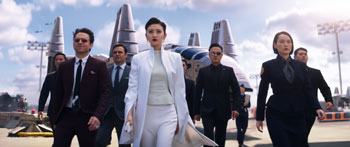 Spaeny singles out Boyega for going above and beyond, on set and off set. "John took me under his wing; he wanted to help me in this process. Jake is very jaded, and John's the complete opposite. He's an amazing person, and I got so lucky that he is an actor I now look up to."
Spaeny singles out Boyega for going above and beyond, on set and off set. "John took me under his wing; he wanted to help me in this process. Jake is very jaded, and John's the complete opposite. He's an amazing person, and I got so lucky that he is an actor I now look up to." Her co-stars were equally impressed by the work of the newcomer. Boyega praises: "Cailee's innocence allowed for this fresh way of approaching her breakout role. That's something that Cailee handled very well. As much as I've done, I learned from her and we genuinely had a strong bond and great chemistry."
Eastwood adds: "Cailee's incredible. She lights up the screen. She's got a big career ahead of her. She brings that young innocence, but she has something about her that you can't put your finger on. She was so honest in her performance."
When Mako lost her parents during a Kaiju attack years ago, she was saved by Stacker Pentecost, who adopted her. Mako became a student in the Jaeger Program, where she trained to become a Ranger with an exceptional record. At the end of the first film, she and Raleigh teamed up to pilot Gipsy Danger, and saved the world from the Kaiju.
In Pacific Rim Uprising, Mako holds the rank of Secretary General at the PPDC and offers her estranged brother the choice to avoid jail time by helping train the Cadets. Mako knows that Jake is a great pilot and she finds a way to lead him back.
Japanese actress Rinko Kikuchi, who returns to the role, says of the character's transition to the new film: "Over the past 10 years, Mako has had to struggle with the sadness of her past. She lost people she loved, so she's always been brave and tough, but now she's tougher."
Regarding Mako's faith in her little brother, Boyega asserts: "Mako's belief is that Jake can become a good leader himself, he could be the best version of himself if he just tried. Her unwavering belief motivates him to turn his back to the mistakes that he made and step up to become the man that she knows he is."
Of collaborating together, Kikuchi says: "John was perfect for the role. It was great fun to work with him, playing off that sister and brother relationship." She has equally kind words when it comes to working with director DeKnight: "Steven gave me his thoughts about Mako's character and enough time for me to then find my character on set. He brought his vision without changing the Pacific Rim universe."
Another powerful player on the frontline of Jaeger defense is Liwen Shao. She is the founder and owner of Shao Industries, a private innovation company created with the goal of protecting the world from future Kaiju threat. She's ruthless, clinical and incredibly determined; it seems that nothing will stop her from achieving her goals…and she's willing to do anything to reach them.
Liwen's primary drive and focus is to have her drone Jaeger program implemented by the PPDC. She's designed a brilliant feat of engineering by which a single pilot can operate the drone via a remote link, side-stepping the need to find and train drift-compatible pilots. She sees the program as a chance for cooperation with the existing Jaeger pilots; they see it as a chance to shut them down.
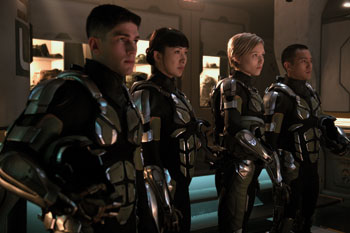 Chinese actress Jing Tian, who portrays Liwen, feels that her character "is a genius. Very few people on the planet can match her intelligence and work ethic. Having been the victim of the original Kaiju attacks, Liwen has devoted her life to stopping future ones. While she's amazingly successful professionally, socially she comes off as cold and unfriendly." The performer reflects: "Liwen is a very powerful and successful character, but she has her flaws."
Chinese actress Jing Tian, who portrays Liwen, feels that her character "is a genius. Very few people on the planet can match her intelligence and work ethic. Having been the victim of the original Kaiju attacks, Liwen has devoted her life to stopping future ones. While she's amazingly successful professionally, socially she comes off as cold and unfriendly." The performer reflects: "Liwen is a very powerful and successful character, but she has her flaws." In the first chapter, Dr. Newton Geiszler, or "Newt" for short, worked at the PPDC, becoming the foremost expert on the Kaiju. The scientist was able to devise a way for humans to drift with Kaiju brains, discovering the true nature of the Kaiju and the Precursors, and eventually helped to close the Breach.
In Pacific Rim Uprising, Newt has moved into the private sector, working for Shao Industries as head of research and development. He's rewarded for his important research on the drone project with a large salary, but must work under Liwen's steely thumb. As a result of the unexpected attack by the rogue Jaeger Obsidian Fury, Liwen forces Newt and his team to deploy the drones earlier than scheduled"perhaps too early.
Performer Charlie Day, who returns to the role, says: "It's nice to be able to bring that knowledge of my character and all his history to the second film. I hope that audiences will be excited to see our characters return, as well as to meet the new ones…and to go on a breathtaking new adventure."
In Pacific Rim, Gottlieb was a fellow scientist partnering alongside Newt in the trenches. Under pressure and with little funding, they worked tirelessly to do the best they could. While Newt has moved into the private sector, Gottlieb has remained at the PPDC. Still, with more robust funding he devises innovative chemical and biological ways of advancing our defenses against future Kaiju attacks.
As the film opens, Gottlieb is working on a Kaiju blood-reactive fuel system, but needs his old friend's expertise to balance the equation, knowledge that Newt isn't keen to share. Gottlieb's insightful discoveries will prove crucial to later events.
Burn Gorman, who returns to the role of Dr. Hermann Gottlieb, shares: "Gottlieb is great fun to play, because he's spiky and opinionated, but ultimately has a heart of gold. He's now respected and able to access the resources he needs, so we find him in a better place, but he's working without Newt and misses him. He's a lonely, eccentric character, a cerebral guy who's led by the search for answers. His communication skills are terrible, but he means well."
Of the split between Newt and Gottlieb, Gorman says: "One of the reasons that the relationship is more complex in this film is because Newt has gone into the private sector and there's a certain amount of hurt. He hasn't found anyone who matches him for enthusiasm and knowledge, and Newt is very clever man."
Another key player in the PPDC is Jules, a J-Tech and mechanic at the Moyulan Shatterdome. Charged with running a team that keeps the Jaegers in perfect condition, she's the object of Lambert's affections. Not surprisingly, when Jake Pentecost arrives, he's also drawn to her power and confidence.
Puerto Rican actress Adria Arjona, who portrays the mech, says: "Jules is definitely a fixer. She's very strong, reacts quickly and decisively, and has very little room for distraction. She has her guard up, but when she lets it down you can see that she's as soft as everyone else."
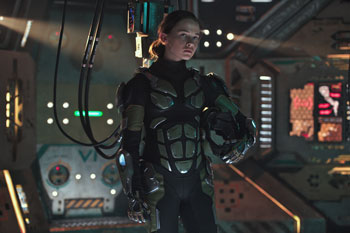 To understand Jules' world, Arjona visited the USS Midway in San Diego and was guided through the mechanical workings of fighter planes. The presence of strong female characters in the screenplay immediately struck Arjona: "The first thing I felt when I read the script was that there were very strong male leads, but that the characters who carry the film are the females."
To understand Jules' world, Arjona visited the USS Midway in San Diego and was guided through the mechanical workings of fighter planes. The presence of strong female characters in the screenplay immediately struck Arjona: "The first thing I felt when I read the script was that there were very strong male leads, but that the characters who carry the film are the females." The actress recognized that there was much to relate to in the film for different audiences. "That's a special thing in such a big movie," she proudly states. "Little girls will be able to watch it and relate to it, and so will 40-year-old men. You have strong girls, not chasing after a guy but working with and leading these men, and the men respecting them. Jules is a strong woman who is good at her job, and I think that this will prove to girls, including Hispanic girls, that it's okay to have an opinion. It's okay to be strong. There's nothing wrong with that."
Of the diversity of the cast, Arjona says: "We have a Cuban, a Puerto Rican, a girl from the States, a guy from Hong Kong, a British actor of Nigerian heritage. There were so many different people and they threw us all together and we became a little family; that shows onscreen."
She tells that the core of the production was truly their director: "Steven gave us the liberty to explore. In a production like this, it's hard to give actors liberty, because time is money, but he did. His priority was his actors, and he let us play and improvise in a film this big. He brought something really special to the table: he gave it heart."
Last but not least, Marshal Quan is the highest ranking PPDC official at the Moyulan Shatterdome. He's officious, efficient, and a highly capable commander. Chinese actor Max Zhang, who was cast as the Marshal, trained from a young age in martial arts, and was a wushu athlete before commencing his film career as a stunt actor in Ang Lee's 2000 blockbuster Crouching Tiger, Hidden Dragon"later moving into roles that combined his athletic and acting skills.
Pacific Rim Uprising was Zhang's first experience working at Wanda Studios, and its scale impressed him. "It's a huge complex, with so many stages," he notes. "I'm happy that the film industry has evolved so fast in China, and I hope that we can do more movies like this."
Of working with Boyega, Zhang commends: "John is like a superhero in this film, and he is very interested in the martial arts. He told me that he'd seen at least one of my former films, so I hope someday I can work with John in a martial-arts movie."
Meet the Next Generation: Cadets of the PPDC
Given their massive size, Jaegers require multiple pilots working in tandem. Connected mind-to-mind via a neural bridge known as "The Drift," pilots have to be "drift compatible": achieving a state of physical and mental synchronicity with each other, through the shared connection to a Jaeger. In the first film, those united by DNA or emotional ties"brothers, fathers and sons, husbands and wives"were the most drift compatible. In Pacific Rim Uprising, a program has been developed by the PPDC to expand how people from different backgrounds and experiences achieve synchronicity.
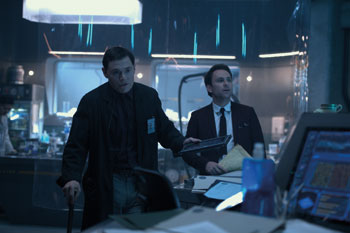 The young cadets in this elite program are called the Cadets, and director DeKnight explains what it means to have this connection: "The idea is that if you start training someone young, they'll become a better pilot and will form a stronger mental link with their co-pilot. The drift compatibility can be nurtured over time."
The young cadets in this elite program are called the Cadets, and director DeKnight explains what it means to have this connection: "The idea is that if you start training someone young, they'll become a better pilot and will form a stronger mental link with their co-pilot. The drift compatibility can be nurtured over time." During the final act of Pacific Rim Uprising, the Cadets are the only force standing between the world's destruction from the Kaiju and its survival. These teenagers of varied backgrounds and experiences have been handpicked from different corners of the world; trained from a very young age, they must stand up and become heroes.
"It's wonderful for kids in our audience to be able to see themselves in that way," says Boyega. "It correlates to their own lives and the obstacles they have to face. They can see in this film strength coming from people who are like them, and that anybody can be a hero. Anybody can live up to their true potential, and you see that through Amara, Suresh and all the members of the Cadets."
Spaeny was spurred on by her fellow young actors from across the globe. Truly, the performers found this tight knit unit, living and working side by side for the many months before and during the shoot. "The cadets are so passionate and driven, and they want to fight and to help the world as much as they can; the actors who played them were amazing," Spaeny says. "We had each other's backs, we had meals together, went to karaoke together; we'd have life talks. They're my family now, and I'm so excited to see where all of them go."
Of the diversity, actor Karan Brar (Cadet Suresh, the youngest of the Cadets) says: "Steven and the producers made sure this cast was very diverse. That is incredible because, regardless of where this film goes internationally, kids can look up and look at a screen and think, 'They're just like me, I could be there.' I've had those moments with actors who I look up to, so hopefully when this film plays in India, a kid will see me onscreen and think 'I see someone like me up there.'"
For Brar, the joy of his job during production: "was being able to make the impossible happen. We're supposed to be in giant robots fighting giant monsters. The actors and the crew make it happen, and that's the amazing thing about movie magic, we made the impossible happen."
His colleague, Cadet Jinhai grew up in a military environment in China, groomed from birth to become a part of this highly disciplined unit of cadets. One of the kindest of the corps, he becomes particularly close to Amara. "Jinhai's parents were Jaeger pilots," explains Hong Kong-native Welsey Wong of his character, "so he grew up in a family environment connected to this world. Now he's part of the Jaeger program as well."
In his first scene, Jinhai is seen doing inverted crunches off a bunk bed, so a rigid exercise and diet regime for Wong began four months before shooting. To prepare emotionally, Wong went to an ideal source. "I visited a pilot in China, who flew jets in the Air Force," the actor says. "He told me a lot about the thoughts of someone like Jinhai, who had army parents who had to go out to fight. Now the kid is in the same position, and the pilot talked about how that would affect the kid and his parents. That helped me a lot in my preparations."
In one scene, Jinhai shares a Conn-Pod with not just one co-pilot but two"Cadet Viktoria "Vik" and Amara, increasing the difficulty of achieving synchronicity. "I'd rehearsed with Ivanna Sakhno, who plays Vik, but I'd not rehearsed with Cailee. The first time all three of us were in the Conn-Pod was when we were shooting, and we said 'Okay, let's do this!' Working in sequence together was completely different, but when we saw the playbacks it looked very cool."
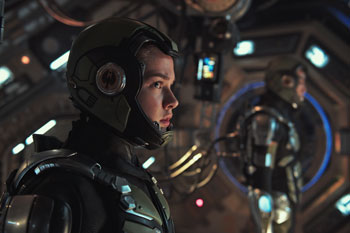 Russian Cadet Ilya has a dry sense of humor and a seething intensity. He's often in his own head, challenging himself to be the best, yet questioning whether he can be. Canadian actor LEVI MEADEN, who portrays Ilya, partly focused his preparation on perfecting a Russian accent. "I had a great dialect coach, and I spent a lot of time watching Cronenberg's film Eastern Promises and reading a lot of Russian literature, Dostoyevsky mostly."
Russian Cadet Ilya has a dry sense of humor and a seething intensity. He's often in his own head, challenging himself to be the best, yet questioning whether he can be. Canadian actor LEVI MEADEN, who portrays Ilya, partly focused his preparation on perfecting a Russian accent. "I had a great dialect coach, and I spent a lot of time watching Cronenberg's film Eastern Promises and reading a lot of Russian literature, Dostoyevsky mostly." Meaden sees the Cadets as preparing for what could be, with no initial signs that danger is coming. "The Cadets were very young when the attack occurred 10 years ago, so it hasn't had a huge influence. They grew up in a world of fear, but they didn't understand the full gravity of the situation. The cadets have been raised to be revved up and on edge and ready to fight at any given moment."
Cadet Vik had a tough upbringing, and is constantly aiming to prove herself. Losing both parents in a Kaiju attack, it took great self-reliance and persistence to get to the training program at the Moyulan Shatterdome. It has now become her home, and the people in it her only family. The arrival of child prodigy Amara brings out a defensive edge in her.
Of her character, Ukrainian actress Ivanna Sakhno says: "When Amara comes into the group, Vik becomes angered, not because she's a bully but because she's so protective of what she has. She doesn't want to have it taken away from her by this young girl, with all her talent."
During the months of training before arriving on set, Sakhno researched strong females in films and in real life, to gain a deeper understand the commonalities of strong female figures. "I looked at many types of women, including politicians, for example. I watched Angela Merkel, and observed the way she acts, moves and talks. Studying women with a strong core helped me a lot in shaping who Vik is."
Ryoichi, an excitable, energetic Hopeful, is portrayed by Mackenyu Maeda, who was shooting a television drama series in Japan when he learned that the part was being cast. "I sent in a video audition, and got a call back," Maeda remembers. "The Japanese producers gave me 24 hours to go to Los Angeles, so I got on a plane, met with Steven, then flew back and shot again in Japan. It was bizarre to fly for such a brief meeting, but definitely worth it!"
Ryoichi pilots the Jaeger Saber Athena with Cadet Renata (Shyrley Rodriguez). "The Jaegers have become faster over the past 10 years, but Saber Athena is the fastest, so I have great pride in it," Maeda says. "Since I was a boy, the idea of fighting Kaiju with a robot that you're in control of was a dream, so co-piloting Saber Athena was a dream come true. Filming those scenes was hard work but incredible."
Cadet Tahima is of Maltese origins, but grew up in Sydney, Australia. As with the other cadets, Tahima wants to seek revenge against the Kaiju, who displaced his family when they attacked Sydney.
Australian actor Rahart Adams, born to parents of Maltese heritage, was cast while in Los Angeles. Of the process, he recalls: "When I read the script, it was mind-blowing because there were all these new elements of the Pacific Rim universe. It was a lot to wrap my head around, but was so exciting because I'd never been a part of something so big."
Like his fellow cadets, Adams was awed by the overall scale of the production. "I had to pinch myself every time I walked onto a set. Especially the night shoots with 20-foot-tall blue screens and explosions going off. The detail for everything was amazing."
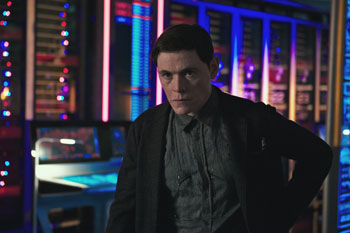 Cadet Mei Lin is originally from Guangzhou, in southern China, where her parents were killed by the Kaiju during the attacks a decade ago. Chinese actress Lily Ji, who portrays the character, elaborates on the backstory she created for her character: "Mei Lin then went to the Cadets' training center; she felt she had to become a soldier to avenge her parents. She grew up alone, and has felt a lot of pain, but she's very strong and tough."
Cadet Mei Lin is originally from Guangzhou, in southern China, where her parents were killed by the Kaiju during the attacks a decade ago. Chinese actress Lily Ji, who portrays the character, elaborates on the backstory she created for her character: "Mei Lin then went to the Cadets' training center; she felt she had to become a soldier to avenge her parents. She grew up alone, and has felt a lot of pain, but she's very strong and tough." To immerse herself in the role, Ji details: "I trained like a soldier and ate like a soldier, but I also kept a handwritten journal written in Chinese, documenting the cadets' lives. I felt that Mei Lin's mom, even though she was now gone, would want her to keep a handwritten journal, so it would feel like a personal, intimate diary."
Of working and bonding with the other cadet actors, Ji says: "We trained together, ate together, we watched films. We learned bits of each other's languages, and gradually we became this family. We found ourselves bonding like the Cadets, through our daily activities."
Finally, Cadet Renata is a sporty and vivacious character. Rodriguez describes her as "sweet, but spicy. I'm Cuban-American, I'm first generation, and Steven was very open in letting us do your thing. So, I decided to make my character Cuban so I could take some of my family history and use that in crafting her…and find those elements to make her more real."
Renata derives from "born again," and that's what the character and the other Cadets represented to Rodriguez. "It's a dark time, there's a lot of uncertainty and these young people are light-bringers; they bring hope."
The aspect of the film that most impressed her, though, was its message and how crucial she sees it to the contemporary world. The actress says, hopefully: "We're all from different places, we communicate differently, have different languages. If audiences watching Pacific Rim Uprising can see that in this world we coexist and work together for a good cause…why aren't we doing this in our real lives? When we're children, we don't let our differences separate us. Being different is irrelevant. The film will entertain and excite audiences, and I hope it may also help people open their eyes more to working together for a better world."
Scale and Strength: Kaiju versus Jaegers
In the Pacific Rim universe, the Kaiju are giant monsters that erupted from the depths of the Pacific Ocean. Entering our world through the dimension-spanning portal called the Breach, they are living weapons of mass destruction, bio-engineered to terraform planets. In Pacific Rim Uprising, the Kaiju evolve into a deadly and unexpected new species.
In Japanese, the word "Kaiju" literally means "strange beast," but is more commonly translated as "giant monster." DeKnight, who grew up watching the Japanese Kaiju movies of the 1950s and '60s, reminisces: "I loved them as a kid, back when it was the man-in-a-suit approach. What I love about doing a Kaiju film now, with the technology we have, is that we have a chance to make it that much more spectacular. As much as I love the nostalgia of those original films, even as a kid I knew it was a guy in a rubber suit"stomping on miniatures. When our Kaiju attack a city, it feels completely real. The threat and the drama feel immediate."
Increasing in strength and ferocity, each Kaiju is an entirely new species with its own powers and attack patterns, perfectly evolved to do battle. While no two Kaiju are the same, they share a common goal: the extinction of the human race. In the face of this lethal foe, the Jaegers are humanity's only defense.
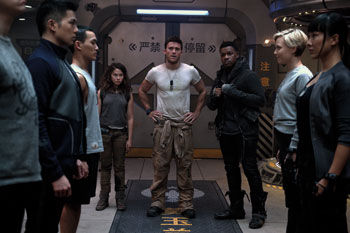 Being in control of a Jaeger has never been more thrilling. Pacific Rim Uprising brings its heroes and the audience even closer to the action with cutting-edge technology and wildly inventive battle tactics. The film features the next generation of robotic guardians, sporting brand new weapons systems and abilities, as well as newly designed cockpits. These Jaegers stand as tall as 25-stories, and they are faster and more agile than ever before"as well as vary in terms of scale.
Being in control of a Jaeger has never been more thrilling. Pacific Rim Uprising brings its heroes and the audience even closer to the action with cutting-edge technology and wildly inventive battle tactics. The film features the next generation of robotic guardians, sporting brand new weapons systems and abilities, as well as newly designed cockpits. These Jaegers stand as tall as 25-stories, and they are faster and more agile than ever before"as well as vary in terms of scale. Each Jaeger is an extension of its pilots, and so each has a unique fighting style, movement style and personality. On DeKnight: "When we first meet Amara, she's built her own Jaeger out of scrap. Scrapper is about 40-feet tall, so she can run it herself; although made of junk, it has the ability to curl into a ball and roll fast to get away. Amara's also included defense mechanisms like smoke bombs"things that a kid would think of."
In the film's opening action sequence, Amara and Jake are forced inside Scrapper at the same time to avoid a pursuing Jaeger, and the smaller size and different capabilities give Scrapper a fun, dynamic feel.
Boyega brought Liang Yang onto the film, with whom he'd first worked on Star Wars: The Force Awakens, to advise on the fight sequences. He decided to think in terms of not just how humans move, but also the newly acrobatic and agile Jaegers. Boyega says: "We wanted to make sure that we could show that these skills are a very significant development from what was done in the first film. So, we brought on Liang, who is an expert in martial arts, to take a look at the pre-visualizations. Once Liang got a hand on the pre-visualizations, he built on top of the fantastic ideas that Steve had. Liang had a great collaboration with the visual effects team, and a lot of the sequences in the confrontation scenes will shock the audience."
Spaeny had to train for not only the smaller Jaeger, Scrapper, but for Gipsy Avenger. "Operating Scrapper required a skiing-type motion that I trained for weeks to perfect," the actress explains. "It was a very specific movement, and I didn't need to sync up with anybody else. The Gipsy Avenger Conn-Pod was more difficult. Since I had to sync up with John, who's taller than I am, we had to figure out our relative length of steps were and how to time that out. There were a lot of rehearsals for the choreography in the Conn-Pods, on top of the fight choreography. It was a unique experience."
Unique indeed, as the vision for the Jaegers and their interior technologies had evolved since the first film. DeKnight explains: "Inside the Jaegers, we redesigned how the pilots are connected. They're not so bolted in, they have a full range of movement; they can spin-kick, and they can leap. It's much more dynamic and exciting."
In the first film, Gipsy Danger was detonated. Still, as the PPDC considered it the hero robot, so they rebuilt it and renamed it Gipsy Avenger. "Gipsy Avenger is essentially Gipsy Danger 2.0," says DeKnight. "It's the Starship Enterprise of this universe: the flagship Jaeger."
Gipsy Avenger's Conn-Pod was built on a large motion rig that could move in many directions and execute wild movements. Eastwood, who as Lambert operated the Jaeger, states: "Because the Conn-Pod is hydraulic, it could do everything from slams and big jerks. It was like being on a rollercoaster; we were plugged in and along for the ride."
The Conn-Pod itself was a relatively tight space, and that required great dexterity and sensitivity from both cast and crew. Eastwood continues: "Sometimes you look at a scene on a page and think, well, this is easy. But when you get to set, the crew also needs to be able to move in and out to make adjustments"all the departments need to operate in that space. It suddenly became more difficult than it looked on the page. Still, good crews and actors know how to work with each other, and we made it happen."
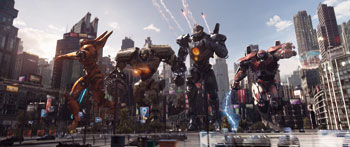 Boyega was equally impressed by a new hologram aspect of the design. "When Gipsy Avenger is attacked, a 3D hologram version of the exterior is displayed inside the Conn-Pod that the pilots are able to interact with. As actors, that allowed us to more effectively play the strain and the pain of piloting one of these things. It also created a more complex style of fighting, which allows the audience to buy in that much more."
Boyega was equally impressed by a new hologram aspect of the design. "When Gipsy Avenger is attacked, a 3D hologram version of the exterior is displayed inside the Conn-Pod that the pilots are able to interact with. As actors, that allowed us to more effectively play the strain and the pain of piloting one of these things. It also created a more complex style of fighting, which allows the audience to buy in that much more." Spaeny researched intensively to understand the mechanical mind of Amara, and felt it important to convey to the audiences that Scrapper also embodies the character. "It takes someone exceptional to think through how to build something like Scrapper, so I talked to the people on the production team who drew the blueprints, learned how it differed from other Jaegers, how the different parts would have been assembled from parts in the environment around her."
The actress reflects that the Jaeger is so much more to her character than simply a machine: "Scrapper is Amara's only friend; she's committed her whole life to this Jaeger that has such a personality, so it mirrors her." Life imitating art proved a very special moment for her. "I got to make a part of the part Scrapper that was constructed for filming. I wanted to feel what it was like to put those parts together, so I was allowed to weld a few pieces together, which was awesome. I wanted to get my brain wrapped around that part of Amara."
A Worldwide Undertaking: Locations of the Film
The majority of production took place at Fox Studios in Australia, with exteriors lensed in multiple places around Sydney and Brisbane. Additionally, scenes were captured on the sound stages at Wanda Studios in Qingdao, China; those were followed by location work at Mount Fuji in Japan, in Seoul and Busan in South Korea…as well as at waterfalls and glaciers in Iceland. The pure scale of the undertaking would be a challenge for the producers, with a crew of 500 on set at Wanda Studios alone.
"The scope of the film was massive, in terms of the different locations," offers producer Boyter. "The size of the cast was something I'd never had to contend with before, there were people coming in and out every week. We had a huge number of Chinese talent, as well as talent from London, the U.S. and Australia. It was challenging, but also a lot of fun to see it all come together."
Australia became an obvious fit because the team needed to find a studio location that had a combination of the stage space, a competent crew base, but also allowed them to maximize exteriors. Fortunately, the infrastructure was in place. "There were a lot of big movies shooting in Australia at the time," says Boyter. "It was a good fit as it was summer there, so we were able to jump in and out of stage work and exterior work. Additionally, given that the Australian crews have experience working on big movies, it checked all the boxes. It was a hardworking, passionate group of people, so it was seamless."
Pacific Rim Uprising was the first U.S. production to be filmed at the massive, state-of-the-art Wanda Studios. "We were the guinea pig, and it went really well," says Boyter. "We had the language aspect to negotiate around, but we hired the right people to help us bridge the cultural gap and once we cracked that code, we started humming along."
Brave New World: Designing in the Light
A film in which giant robots fight giant monsters requires a scope and scale that is extraordinary, but the first step was to determine how Pacific Rim Uprising would differ visually from the first film.
DeKnight and the producers agreed that the effects in Pacific Rim were spectacular, but that they wanted to take the second film in a boldly different direction. Stefan Dechant was engaged as the film's production designer. Coming from an art director and illustration background, Dechant's role broadened into taking charge"alongside DeKnight and director of photography Dan Mindel"of the plans for the entire visual world.
Dechant recalls: "In my very first conversations with Steven, he expressed that he wanted the film to stand on its own. Despite having its roots in Guillermo del Toro's first movie, it needed its own vision, its own feeling, and its own tone."
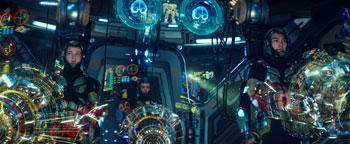 Of the key difference he conceived, DeKnight explains: "In the first movie, most of the attacks happen at night in the rain, and it's atmospheric. But for Pacific Rim Uprising, we wanted to make the majority of the fights during the day. You get a different feel, you can see the entire city and you can get a good look at the monsters. That made it exponentially more difficult, because we couldn't hide anything in the daylight, but at the same time we were all very excited about the possibilities."
Of the key difference he conceived, DeKnight explains: "In the first movie, most of the attacks happen at night in the rain, and it's atmospheric. But for Pacific Rim Uprising, we wanted to make the majority of the fights during the day. You get a different feel, you can see the entire city and you can get a good look at the monsters. That made it exponentially more difficult, because we couldn't hide anything in the daylight, but at the same time we were all very excited about the possibilities." The movie and its design would also have to reflect a world 10 years beyond the first. "In the first film, humanity is very much on the back foot," shares Dechant. "In this film, it's a post-war situation. There is money; the PPDC is putting things together and developing technologies and we wanted to explore what that world could look like. We wanted to have more environments at different times of days, different tones. We also wanted to open up some of the Shatterdome sets and let some light in. We wanted to change the color palette, to open up the scope of the exterior fighting scenes."
For Dechant's crew, the imprint would be not just in the physical world of the film, but the creatures inhabiting it. The first eight weeks for the art department were spent designing the Jaegers and the Kaiju. An important distinguishing aspect for both was decided early on, to give a structure to the design process that would follow.
"The idea for the Kaiju and the Jaegers came from Cale Boyter. He talked about giving each unique Jaeger and Kaiju its own specific attribute that separated it from everything else," explains Dechant. To accomplish, DeKnight and Dechant had a team of artists in the Industrial Light and Magic art department developing Gipsy Avenger and the other Jaegers, followed by the Kaiju.
For the Kaiju, storyboard artist Doug Lefler and DeKnight laid out what the attributes for the three major Kaiju would be. In keeping with the "let personality inform the design" approach, Dechant explains: "When you look at Saber Athena, for example, she's all about speed, swiftness and her swords. With the Kaiju Strike Thorn, we took the name and created a creature that throws out giant thorns. They evolved out of the storytelling, so that our design was folding around the cinema that Steven was creating."
The team would pose questions and possibilities, such as "What would it feel like if the Jaegers were like fighter jets?" "There were times where we got much too slick," notes Dechant, "but it was a process of getting the images down on paper, reviewing, and adjusting."
The production designer appreciates that he had a like-minded director to bring his visions to life. Dechant adds: "Steven is an exceptional designer in his own right, so we could start communicating back and forth in sketches. It was just a nice process to just be with him in creating these environments and these robots."
With the basics of the visual landscape and the creatures set, DeKnight and Dechant then sat down with the illustrators to tell key moments in the film.
Practical and CGI: Visual Effects
As Pacific Rim broke new ground with its VFX, the bar was quite high for this production. Visual effects supervisor Peter Chiang (Star Trek Beyond, The Bourne Ultimatum) was called in. Boyter recalls: "We needed a visual effects supervisor who had great instincts and a passion for what we were trying to do. We said to Peter that we didn't want to do anything that we'd seen before. We showed him where we were, and he said, 'Give me a few days, I'll be back with ideas on how to evolve what you're doing…'"
Chiang felt it was crucial to get DP Mindel and PD Dechant's contributions immediately. Chiang had previously worked with Mindel, and knew that the DP preferred for the camera department to shoot plates. That would allow the VFX team to base their work in reality…an approach that DeKnight was also keen to follow.
"I come from a drawing background," Chiang explains, "so I storyboarded a lot of the visual-effects-heavy sequences, designing a lot of the action beats for Steven, so that his approval or comments on them would lead to the pre-visualization process. A team of three companies"Halon, Day For Night and The Third Floor"all did various parts of the pre-visualizations. Then, during the shoot, we captured plates with Dan Mindel and his team, and then finished in postproduction with computer graphics."
Given the scale of the Jaegers and Kaiju, VFX would be a dominant force. "We took over anything that couldn't be done physically on set," says Chiang. "In terms of scale, you can hit somebody over the head with a fake bottle provided by the special effects team, but when the script calls for 270-foot tall robots smashing through buildings, crushing cars and fighting giant monsters…that's when my team needed to come in."
The supervisor admits he saw the opportunity as "a visual effects dream. It involved, first of all, smashing up a lot of buildings, which visual effects people love to do. Added to that, there are other films out there with large monsters, but to have a film that revolves around such massive objects, that's amazing to work on and realize."
In order to achieve as much realism as possible, DeKnight and Chiang would still use a practical base as a starting point. "Practical effects give us the basis from which to work," offers Chiang. "They give us clues that we expand from. For example, there's a sequence with Scrapper, the 40-foot Jaeger. The art department built a small section of the leg, and this gave us fantastic clues as to what the real robot would look like if we could have built the full thing."
During the acquisition process on set, Chiang's team gathered data about every aspect of the live-shooting strategy"lenses, camera heights, focal lengths and lighting conditions. A huge team of data wranglers captured photographs and carried out LIDAR scans all over the sets and locations. "A huge volume of data was captured during the live shoot," says Chiang. "This information was invaluable to us during postproduction. When we place large robots and Kaiju into the scene, it enables us to light them the way that Dan lit them in the plates."
The plates would also be a safeguard. If it were later decided to change a line of dialogue or reshoot an actor, rebuilding a set or returning to a location could be avoided by filming the actor against green or blue screen, then replacing them in the scene.
The challenges for Chiang's team were mostly about scale"trying to shoot a plate or a location in order to work for the script. "The span of Gipsy Avenger is 70-feet alone, so if it is running down a street, that street needs to be at least five lanes wide in order to accommodate its running gait," says the VFX supervisor. "Imagining what a 270-foot-tall robot would be like in that space, working out timing when it's running. There's always a payoff between moving slowly in order to convey scale, and the desire for fast action; those were huge challenges."
The desire for more daylight also meant not being unable to hide anything under cover of darkness. Chiang notes: "The film takes place in 2035, so we needed to create a slightly futuristic look by adding CG to the present-day plates, which had to blend seamlessly as though it had been physically built. The depth of field, how the sun was in that particular environment, all of that information is key to us seamlessly blending our work into the preexisting plate. It's harder because it's daylight, but it was a great challenge and gives a great look."
The VFX team comprised different companies in varying time zones, working at different speeds, with a total of 2,000 members. Chiang had to ensure that each was working seamlessly with colleagues, integrating with DeKnight's vision and with the other departments. "I was constantly dancing between various roles to make sure that all the trains kept moving forward. The most fascinating thing about the film business is that it combines the personal experiences of everyone working on it together to achieve that one goal. A two-hour film is time-stamped with the efforts of those people coming together, working together toward a unified vision. "
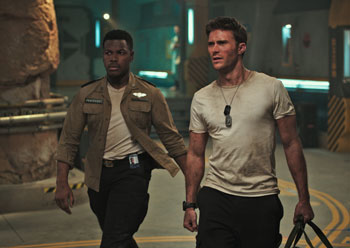 Super Tankers in the City: Cameras and Construction
Super Tankers in the City: Cameras and Construction Camerawork
DP Mindel was brought in during the concept art and pre-visualization process, while the script was finessed, to refine the world in intensive discussions with DeKnight, Dechant and Chiang. Mindel's focus was on integration. He explains: "I wanted to keep everything smooth so that the viewer doesn't get bumped by choices, so they don't wonder 'Why did they do that?' I tried to give the people in the theater no excuse to look at us for taking them out of the story."
As it was for Dechant and Chiang, scale was a massive challenge for Mindel's entire department. "During the shoot, we had to take a lot of our blue-screen work out into the open air," says the cinematographer. "We built our own arena to shoot in because we needed the square footage and distance. We could only get the perspective we needed by setting ourselves further away from the blue screen than we could on the biggest stage at Fox Studios Australia."
Mindel began working intimately with Chiang's and Dechant's teams, as well as with costume designer Lizz Wolf's crew, early in the process. "I put a member of the lighting department into the art department early on so that we could get constant feedback about what they were creating. This allowed us to build our lighting into the sets without causing a road block," Mindel explains. "It's a very important part of the process. The same thing goes with the wardrobe department; we like to see their color and texture choices early on that so that we're not taken by surprise."
For the DP, there was a lot of CG work that he calls "imagination-based," rather than based on logic. "For a lateral thinker, it's hard to wrap your head around giant robots in a physical space. You have to think, 'Okay, this thing is the size of a super tanker and it's walking down the street. What would be happening to the environment, to the dust? What would be the after-effects of something like that walking through a city?'"
Constructing the Sets
Dechant was mindful that every set his team created, every color they chose, needed to support the overall visual design of the film as well as the camera and costume departments. "There was a constant communication between the art, camera and costume departments as we crafted this world," the PD explains. "Dan, Lizz and I would pose questions to each other like 'How are we setting Liwen apart from the backgrounds? What's the world of Newt like?' Lizz and I made sure that the new PPDC uniform and sets integrated meticulously, and one of the great things about Dan is that he would come in and make that set better than I delivered it."
In creating sets, Dechant first asks himself if they are fulfilling the storytelling. "The next is 'Am I being supportive to the cinematographer, and does he or she have everything they need to tell the story?' The final question is 'Does this service the working crew and the cast?' I want to make sure that we have a set that's easy to get in, easy to work with, and is inspirational to the actors. I want to make sure they have a space that they can feel is real so that they can be in the moment with Steven and create his story."
For Spaeny, this was successfully achieved: "When we'd walk onto the physical sets, they were so intricate that we were put into that world automatically. There was a lot of imagining that the actors didn't have to do, because it was all right there."
DeKnight wanted objects like laptops and tablets to be recognizable, but challenged the art department to think about what these items could look like and how they could function 20 years into the future. Property master STEVE MELTON reveals the logic: "You date a movie by electronics. The minute you see a phone or a tablet, you know the year you're in. Steven would say 'Let's recognize what it is, but push it a little. What can we do with the tablets to make them different?' So, we created a folding technology. The PPDC and Liwen and her team can fold their tablets and put them in their pockets. That was a fun way to advance the vision that I hadn't seen that in a film before."
For Melton, the approach to weapons was to first recognize that they haven't changed a lot over the past two centuries. "From the late 1800s to now, they're similar in terms of how they look and function. What makes a gun futuristic today? Is it that they're battery operated, or that they can be fired using a fingerprint? Those are things that are cutting-edge today. Steven wanted to recognize that it's a gun, so we kept them gritty"a futuristic weapon can look like a toy. For example, we layered them with metals and added a charging light. We gave the weapons a different look, but they're not so outlandish that it takes you out of the film."
For Dechant, the whole production process and how the sets were constructed within it was like improvising as part of a jazz band. "Steven can have an idea, and say to me 'It kind of goes like this…' and I can take that, add my element, bring in Dan and Lizz, and then Steven comes back. It's the visual equivalent of working with Miles Davis and John Coltrane. You're not laying down something that they're going to play, but you're going to collaborate with these people, and what comes out of it is going to be better than you originally thought."
Drive Suits: Dressing Like a Superhero
The drive suits worn by Jake, Lambert and the Cadets in piloting the Jaegers were made by Legacy, a company specializing in crafting film super hero suits (Suicide Squad, Captain America: Civil War, X-Men Apocalypse). Each actor had a precise 360-degree full scan of his or her body created, as the suits would be custom made to their exact forms.
"The drive suits were epic," raves Boyega. "Legacy did a brilliant job in making sure that they were detailed"but at the same time flexible and comfortable"because the Jaeger pilots are basically doing acrobatics and ballet inside of the Conn-Pod. It's great to wear a suit that looks incredible, but at the same time is efficient."
Given the custom and tight form, the actors had to be vigilant. Spaeny laughs: "It took three people to get me inside that suit. No cheating on meals, because it was going to show everything. We also had to plan our bathroom breaks! It sounds glamorous, but it was actually the total opposite."
For the Cadets, the physicality of the suits played a crucial part in being able to convincingly play the scenes. Meaden notes: "When I first put the drive suit on, everything fell into place. I knew how I was supposed to move, how I was supposed to look, what was supposed to happen. The coordination of the movements was complex, but there was no doubt that standing there, chin up and out…you feel like the hero that the world needs."
Brar adds: "It gave you that adrenaline shot of 'We're going to war.' The five minutes that it took to get onto that suit, having three people help you into it, helped you ease into a mindset of 'This is really happening. This is real.'"
Adams had his own particular take on the matter: "I'd played a superhero in video games as a kid, but at a distance. Now I was in the suit, fighting monsters, and that helped the acting because it's working from the outside in. Outside forces were affecting what was going on inside of me, and the suit made all the difference. It was very tight and I could feel the protective plates on my chest and arms, and it was just like boyhood dreams made real."
Physical Training: Preparing For Battle
Getting the cast into peak shape would be essential as their characters came to battle the Kaiju. Throughout pre-production and production, Australian trainer and fitness expert Naomi Turvey was tasked with creating rigorous, differentiated regimens for Boyega, Spaeny, Eastwood and the actors playing the Cadets. She worked on building their lean muscle mass and keeping body fat low"a combination of cardio work interspersed with explosive interval training, and strict diets.
Turvey says of her young wards: "They did such a great job. They were diligent with their training six days a week, focusing on the little things as well, like plenty of fluids and good sleep. They were training so hard, as a sports massage therapist I was able to finish our training work with massage recovery so they were staying as pain-free as possible. We achieved great results; I was proud of them and they looked fantastic."
Many scenes were action-specific, requiring complex choreography. "Within each individual's training program, we incorporated those movements so that they were becoming conditioned to implement them," Turvey continues. "With John and Scott, we were doing a lot of treadmill work, as well as boxing training, so they would be able sustain through the number of takes."
Of the brutal scenes, Boyega says: "This was the most action I've ever done in a movie. It was intense. You don't want to sound out of breath, and Scott and I had a few scenes where we're in full-blown dialogue while running, so the training played an important part. I felt goosebumps and rushes of adrenaline at first. But when I'd complete a stunt that worked well, when everybody was in sync and we got what we wanted out of the scene, it felt great."
Spaeny commenced a three-month regimen of parkour, running, boxing, and following a nutrition guide, before heading to Australia to continue training with Turvey. She was challenged and motivated by the action scenes and stunt work, and despite fears and hesitations, stepped up to give everything she had to the role. "Sometimes a stunt would be called for that required climbing up on a part of the set the size of a building, jumping off and rolling out of it, and I would be terrified. The stunt team would ask 'Are you afraid of heights?' and I'd say 'Yes!' They'd offer for my stunt double to do it, but I'd say 'No, I have to do it. I have to,' and it was a fun challenge."
Pacific Rim: Uprising
Release Date: March 22nd, 2018
MORE





